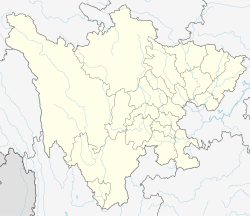Top Qs
Timeline
Chat
Perspective
Luding County
County in Sichuan, China From Wikipedia, the free encyclopedia
Remove ads
Luding County (simplified Chinese: 泸定县; traditional Chinese: 瀘定縣; pinyin: Lúdìng Xiàn), also known via its Tibetan name as Chagsam or Jagsam (Tibetan: ལྕགས་ཟམ་རྫོང་།, Wylie: lcags zam rdzong, ZYPY: Jagsam Zong), is a county located in the southeast of the Garzê Tibetan Autonomous Prefecture in Sichuan province, China.[1] Luding County covers an area of 2,165.35 km2 (836.05 sq mi), and has a population of 86,234 as of 2022.[1]
Remove ads
History
Geography
Luding County is bordered by Tianquan County, Yingjing County, and Hanyuan County to the east, Shimian County to the south, and Kangding to the west and north.[1]
The county is located within the Hengduan Mountains, within the southeastern edge of the Tibetan Plateau.[1] The town of Luqiao, the county seat, sits at an elevation of 1,321 metres (4,334 ft) above sea level.[1] The highest point in the county is Mount Gongga, along the southwestern border with Kangding.[1] Mount Erlang is also located on the county's edge.[1]
Remove ads
Climate
Remove ads
Administrative divisions
As of 2022, Luding County contains the following eight towns and one township:[5]
Remove ads
Demographics

Luding County has a total population of 86,234 as of 2022,[1] up from approximately 80,000 at the end of 2004, and the 77,855 recorded in the 2000 Chinese Census.[citation needed]
Ethnic groups
Luding County has a supermajority Han Chinese population, but is home to a number of ethnic minorities, who constitute about 22% of the county's population.[1] The county's ethnic minorities include Tibetans, Yi, Qiang, Miao, Hui, Mongols, Tujia, Lisu, Manchus, Yao, Kam, Nakhi, Bouyei, Bai, Zhuang, and the Dai.[1]
The following table shows the ethnic composition of Luding County:
Remove ads
Transport
References
External links
Wikiwand - on
Seamless Wikipedia browsing. On steroids.
Remove ads




